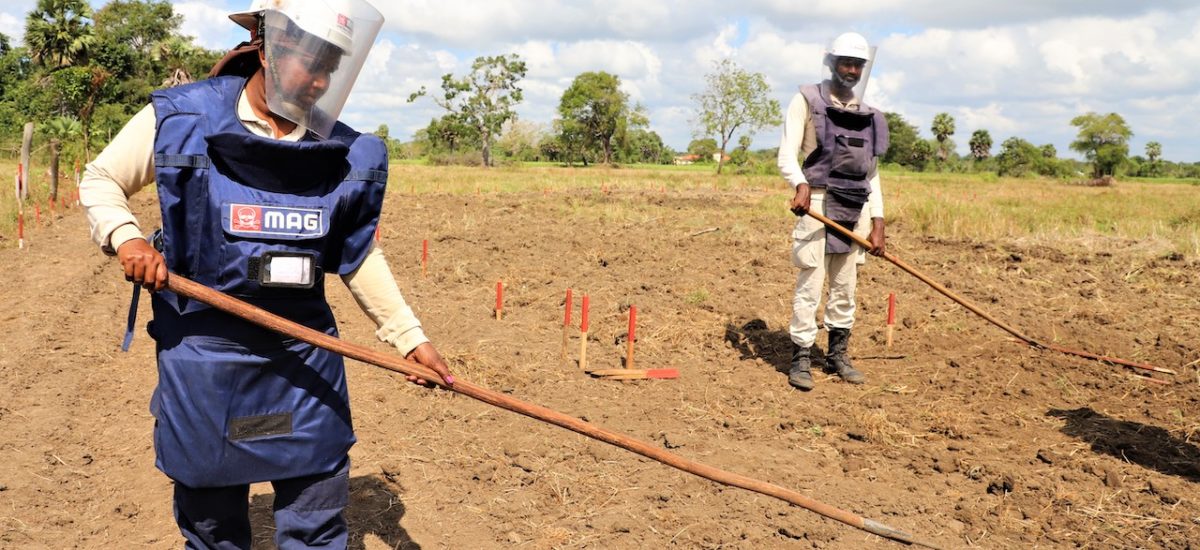Today is International Day for Mine Awareness and Assistance in Mine Action
A protracted war leaves behind many legacies – grieving families, shattered limbs, destroyed homes, disrupted education, lost livelihoods and psychological trauma. One of the lesser known legacies is land blanketed with landmines and Explosive Remnants of War (ERW) consisting of unexploded bombs, artillery shells and missiles, mortar bombs, anti-tank projectiles, rifle grenades and hand grenades.
In Sri Lanka this translated into 1.6 million landmines and ERWs spread over an area of 2,000 square kilometres in the districts of Jaffna, Kilinochchi, Mullaitivu, Vavuniya, Mannar, Batticaloa and Trincomalee where, from 1983 to 2009, one million people were displaced by the war.
Not only do landmines and ERWs kill and maim civilians long after the wars are over but they prevent the displaced from returning home to rebuild their lives and earn a living. Many mines and ERWs appear in fields cultivated by farmers while others prevent fishermen from accessing beach areas. They have also been found in schools, technical colleges, hospitals and national parks. The explosives contained in mines and ERWs can lay dormant for many years but are just as lethal as the day the devices were laid.
Across the world landmines and ERWs, used as weapons of war by both state and non-state actors, killed or injured 6,897 people in 2018 in countries ranging from Afghanistan to Cambodia, Myanmar, Thailand and Laos.
In 1997, the International Campaign to Ban Landmines, a coalition of non-governmental organisations formed to free the world of anti-personnel mines and cluster munitions while helping survivors to lead fulfilling lives, won the Nobel Peace Prize. The group includes the Halo Trust and the Mines Advisory Group (MAG) who operate in Sri Lanka.
Earlier that year, the anti-landmine campaign had received an international boost when Princess Diana, one of the most recognised people in the world, walked through a minefield in Angola, dressed in body armour and blast protective head gear. She was also photographed meeting injured survivors. In August of 1997, she went through a mine field in Bosnia just weeks before her death in a car crash.
In Sri Lanka, where the 26 year long war ended almost 12 years ago, figures show that since the 1980s, 22,193 people have died from landmines and other explosive devices. However it is believed that many deaths have gone unreported especially during periods of heavy fighting.
The northern areas of the country have one of the heaviest concentrations of landmines in the world, planted by both the military and the LTTE. While the military for the most part have records of where they laid mines and thus are able to clear them, the mines laid by the LTTE are discovered only by chance. The Indian Peacekeeping Forces that were in the country from July 1987 to January 1990 also laid mines. Most of the mines in the north and east are found on civilian land.
According to the Landmine and Cluster Munition Monitor initiative, from 2010 to 2018, estimated contamination fell from 506 square kilometres to 25.8 square kilometres. A further 17 square kilometres remains to be demined. The Batticaloa district was declared mine free in 2017, with only residual contamination. The plan is to have a mine free country by 2023 and it seems this will be one plan that can actually come into fruition.
In what was one of the very few successes on the road to reconciliation, Sri Lanka became a signatory to the Ban Land Mine Treaty in 2017 and the Convention on Cluster Munitions in 2018. However, deminers have been working in Sri Lanka since the early 2000s funded by countries such as United States, Germany, Japan, Norway, Australia, and the United Kingdom. Five organisations are involved in mine clearing – MAG, The Halo Trust, Delvon Assistance for Social Harmony (DASH), Skavita Humanitarian Assistance and Relief Project (SHARP) and the Sri Lankan Army. Demining work is coordinated by the National Mine Action Centre (NMAC).
The process is a long, tiring and painstaking one; the deminers who work in the hot sun wearing heavy gear need frequent breaks to get through the day. At each site, an ambulance and medical crew are on standby in case of accidents or staff illness. Earlier in demining activities, dogs were used to detect mines but now only the Army continues to use them.
When a person discovers a mine on his property, he will inform the demining agency working in his area or the Regional Mine Action Office (RMAO), who will send a community liaison team to conduct a non-technical survey to assess whether there is a threat. They will compile a report with the relevant information and issue it to the RMAO so it can decide which agency is best suited to conduct clearance on the task area. The NMAC will be told and the deminers will begin their work, fencing off the area; different coloured sticks denote different levels of danger. An armour plated digging machine then churns up the soil. The driver will be protected if a mine goes off during this process. Then come the deminers in their blast protection gear including reinforced vests and visors. With long handled three pronged rakes, they trawl over the loosened soil, looking for mines and ERWs. When one is found, it is carefully fenced off and identified, awaiting detonation by the Army.
“The impact that mine clearing action has is huge. It not only saves lives and limbs but it also enables people to go back to their fields and cultivate their crops to earn a livelihood. While mines are a legacy of conflict, demining is part of the reconciliation process that enables healing and moving forward,” says MAG’s country director for Sri Lanka, Valentina Stivanello.
Sri Lanka’s long drawn out war means that most mines are buried deep in the earth and covered by vegetation and other layers of various matter, according to MAG’s Technical Field Manager, Andrew Archer. “It is only occasionally that mines can be spotted visually; we have to go deeper to look for them. They are usually laid in lines but sometimes they are scattered. For example, they may be buried at the base of a tree so that when the enemy goes to shelter behind it, they stand on the mines and are seriously injured,” he explains.
The demining organisations work with community liaison officers to keep people educated and aware about the threat of unexploded explosive devices on their land. For Subiah Selvaratnam, a rice farmer in Pulliyankulam north of Vavuniya, the deminers have been invaluable in helping him to gain maximum productivity from his rice fields. Some of his land, dotted with bunkers, was on the frontlines of the fighting so he has kept away from those areas.
Mr. Selvaratnam has six married children and several grandchildren whom he feeds with the rice grown on his fields and from the income he earns from selling the surplus. Displaced from his home in 1990, he returned in 2009 and starting cultivating the safer parts of his five acres of land. In November 2020 he spotted a mine and informed the deminers who were working nearby. Since then they have been hunting for other mines and ERWs in his fields.
“I am happy the deminers are working in my field and that the mines will soon be gone so I can work on my land without the fear of being caught in a mine,” he said.
The demining process has also brought much-needed employment to people who have little opportunities to find work including 38 year old Satheeskumar Revadhi from Vavuniya, who was finding it difficult to feed her three children on her labourer’s wage. Now she can run her family without any problems, including paying for her children’s education, with the steady income she earns as a deminer. “All our work is conducted very safely so I am not afraid. Many people here lost arms and legs in mine accidents so I am happy to be doing this work that will prevent such accidents,” she said.
As the demining programme winds down, the 2,500 breadwinners employed in the sector will have to be retrained and reskilled for other jobs. At MAG, Ms. Stivanello is now working on a demobilising strategy to transition its personnel into other areas of work following the declaration of a mine free Sri Lanka.
Below is a video with excerpts from interviews


